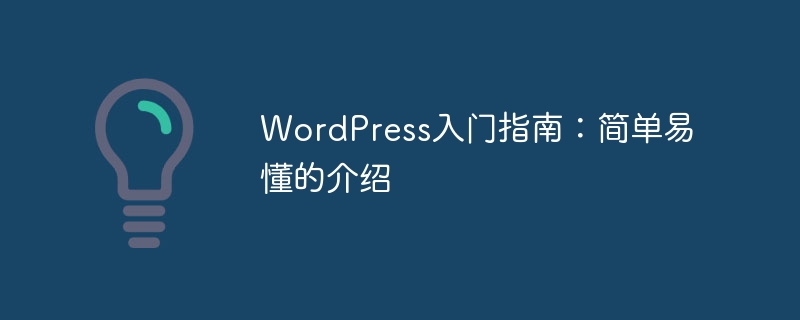

With the continuous development of the Internet, it has become easier and easier to build a personal blog or corporate website. Among many website building tools, WordPress is very popular as a content management system. This article will provide you with a WordPress introductory guide, aiming to allow readers to quickly get started with WordPress and build their own website through a simple and easy-to-understand introduction and specific code examples.
What is WordPress?
First, let’s understand what WordPress is. WordPress is an open source content management system. It was originally a platform specifically used for blog publishing. With the continuous improvement of its functions, it has developed into a tool that can support the construction of various types of websites. It has rich theme and plug-in resources that allow users to easily customize their websites.
Step One: Install WordPress
To build a WordPress website, you first need to install WordPress. Generally speaking, there are two ways to install WordPress. One is to download the latest version of WordPress installation package through the official WordPress website and install it manually. The other is to install it through the automatic installation tool in the website management panel.
The method to manually install WordPress is as follows:
Step 2: Choose a suitable theme
After installing WordPress, the next step is to choose a theme that suits your website style. WordPress provides a variety of free and paid themes, and users can choose the appropriate theme to install according to their needs. In addition, users can also customize themes to suit their personal preferences.
Step 3: Install essential plug-ins
WordPress plug-ins are the key to enhanced functionality. Users can choose to install various plug-ins according to their website needs, such as SEO plug-ins, social sharing plug-ins, form plug-ins, etc. The following takes the installation of a form plug-in named "Contact Form 7" as an example to introduce the installation method of the plug-in.
Step 4: Write Content
One of the core functions of WordPress is publishing content. In the WordPress backend, users can easily publish articles, pages, pictures and other content. The following is the publishing process of a sample article:
Step 5: Optimize the website
In order to make the website more friendly and optimized, there are some commonly used optimization techniques in WordPress. For example, install SEO plug-ins, speed up website loading, optimize website layout, etc.
Summary
Through the above simple introduction and specific code examples, I believe you have a preliminary understanding of WordPress and can quickly start building your own website. In actual use, you can also continue to try and learn to further understand the various functions and customization methods of WordPress to make your website more personalized and professional. I hope this article was helpful to you, and I wish you smooth sailing in the world of WordPress!
The above is the detailed content of Getting Started with WordPress: A Simple and Easy Introduction. For more information, please follow other related articles on the PHP Chinese website!